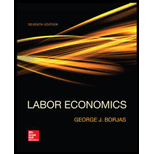
Labor Economics
7th Edition
ISBN: 9780078021886
Author: George J Borjas
Publisher: McGraw-Hill Education
expand_more
expand_more
format_list_bulleted
Question
Chapter 3, Problem 2P
(a)
To determine
Explain the apparent shift in fundamental economic behavior in United States.
(b)
To determine
Explain the authenticity of the statement.
(c)
To determine
Explain the changes in the ratio from 1990 to today.
Expert Solution & Answer
Want to see the full answer?
Check out a sample textbook solution
Students have asked these similar questions
This question is under the Microeconomic Analysis topic.
(a) How does economics describe or define discrimination in general?
(b) What are some typical costs that would come about in an economy from labor market discrimination?
(c) Let us now turn to the labor market for grocery store workers in Little town. Recently one of the last two grocery stores in Little town closed leaving only one employer for grocery store workers in this area. This labor market is not very competitive. What type of market structure is this?
(d) Draw a typical supply curve (i.e. average expenditure), marginal expenditure, and demand for the grocery store in Little Town. Label the equilibrium wage and number of grocery store workers.
(e) Suppose that some time has passed and the population has grown in Little Town and there are now many grocery stores. Now suppose that the grocery store workers unionize. Draw a graph to depict the equilibrium wage and number of workers in this new market.
Need some help please and thank you
Knowledge Booster
Similar questions
- Suppose Hansel and Gretel have the following potential output units for eight hours of work: Nonmarket output Market output Hansel 200 80 Gretel 300 150 (a) in Who has absolute advantage in nonmarket work and market work? Who has comparative advantage in nonmarket and market work? Explain with calculation. Does it impact the household labor division in the household? Explain. (b) (c) disadvantages. What are the gender impacts of such division? Explain both advantages andarrow_forwardD6)arrow_forwardCan someone please help me answer part b please? Refer to the table in the second attached image to help solve the problem. Thank you!arrow_forward
- Problem 2 Let's assume you’ve found the following labor demand and supply curves: Lp 30 – w Ls = 2w (a) Solve for the equilibrium wage and employment level. (b) Graph the demand and supply curves. (c) At this equilibrium, what is your welfare/gains from trade? (d) Now, assume a minimum wage has been implemented at $20. How will this impact your demand? Supply? (e) How many workers are displaced by this new policy? How much “extra" unemployment occurs with this new policy? Hint: Think about the reservation wage. (f) Graph the new labor demand and supply with this minimum wage. (g) At this equilibrium, what is your new welfare? Are you better off with this change? Explain.arrow_forwardQuestion "Minimum wage legislation is enacted to protect livelihoods and reduce the risk of vulnerable employment". Discuss this statement within the backdrop of the Sustainable Development Goals (SDGS) on employment and indicate whether minimum wages are justifiable or not.arrow_forwardDescribe the original rationale and purpose of the creation of a “minimum wage. When did this happen and how many times has the rate been raised? Why is the rate raised at different times in our economic history? Were ethical considerations included in the decisions to raise the rates historically?arrow_forward
- Which of the diagrams illustrates the effect of an increase in automobile worker wages on the market for automobiles? i dont understand why it would be D.arrow_forward(a) Solve for the equilibrium wage and employment level.(b) Graph the demand and supply curves.(c) At this equilibrium, what is your welfare/gains from trade?(d) Now, assume a minimum wage has been implemented at $20. How will this impact yourdemand? Supply?(e) How many workers are displaced by this new policy? How much “extra” unemployment occurswith this new policy? Hint: Think about the reservation wage.(f) Graph the new labor demand and supply with this minimum wage.(g) At this equilibrium, what is your new welfare? Are you better off with this change? Explain.arrow_forwardincludes the wages paid to workers, the cost of any benefits the worker receives, and other expenses related to employing a worker. A) The price of labor (B) Marginal revenue product (C) The wage Take-home payarrow_forward
- Answer question 7arrow_forwardneed to make 2 economic graphs, one being a pro for minimum wage increase from 7.25/hour to 15 dollars. Then a con for the minimum wage increase. - My argument for a pro on the topic is the ability for people to be able to improve their standard of living and many people will come out of poverty. - My argument for con is is business laying off workers due to higher pay.arrow_forwardThe town of Bookville has a massive public library system. Bookville's municipal government faces a tradeoff between retaining the current number of library workers and replacing some of its workers with computers. The four options available to the government are given in table below. Number of workers Number of computers Choice A 30 50 Choice B 20 100 Choice C 10 150 Choice D 5 300 Computers and software cost $5,000 each and must be replaced each year. In a non-unionized labor market, workers are paid $20,000 per year. In these circumstances, the optimal choice from a cost perspective for the city government is Question 4 options: Choice A Choice B Choice C Choice Darrow_forward
arrow_back_ios
SEE MORE QUESTIONS
arrow_forward_ios
Recommended textbooks for you

 Principles of Economics 2eEconomicsISBN:9781947172364Author:Steven A. Greenlaw; David ShapiroPublisher:OpenStax
Principles of Economics 2eEconomicsISBN:9781947172364Author:Steven A. Greenlaw; David ShapiroPublisher:OpenStax


Principles of Economics 2e
Economics
ISBN:9781947172364
Author:Steven A. Greenlaw; David Shapiro
Publisher:OpenStax